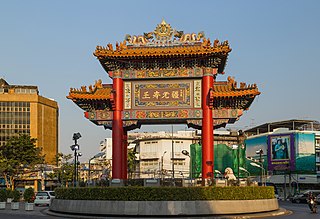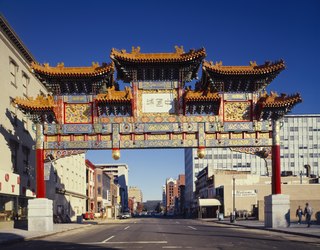
Chinatown is the catch-all name for an ethnic enclave of Chinese people located outside Greater China, most often in an urban setting. Areas known as "Chinatown" exist throughout the world, including Europe, Asia, Africa, Oceania, and the Americas.

Washington, D.C.'s Chinatown is a small, historic area of Downtown Washington, D.C. along H and I Streets between 5th and 8th Streets, Northwest. The area was once home to thousands of Chinese immigrants, but fewer than 300 remained in 2017. The current neighborhood was the second in Washington to be called “Chinatown” since 1931. Originally, the first Chinatown was built in the Federal Triangle on the south side of Pennsylvania Avenue some time after 1851, but was moved to the H Street area when a new federal building was built there. In 1986, a Chinese gate was built over H Street at 7th Street. By 1997, prominent landmarks such as the Capital One Arena, a sports and entertainment arena, occupied the area. The neighborhood is served by the Gallery Place station of the Washington Metro.

A paifang, also known as a pailou, is a traditional style of Chinese architecture, often used in arch or gateway structures.

Sun Yat-sen's Mausoleum is situated at the foot of the second peak of Purple Mountain in Nanjing, Jiangsu, China. Construction of the tomb started in January 1926, and was finished in spring of 1929. The architect was Lü Yanzhi, who died shortly after it was finished. His representative and project partner was his close friend Huang Tanpu.
Events from the year 1986 in art.

Chinatown, Boston is a neighborhood located in downtown Boston, Massachusetts, United States. It is the only surviving historic ethnic Chinese enclave in New England since the demise of the Chinatowns in Providence, Rhode Island and Portland, Maine after the 1950s. Because of the high population of Asians and Asian Americans living in this area of Boston, there is an abundance of Chinese and Vietnamese restaurants located in Chinatown. It is one of the most densely populated residential areas in Boston and serves as the largest center of its East Asian and Southeast Asian cultural life.

Old Town Chinatown is the official Chinatown of the northwest section of Portland, Oregon, United States. The Willamette River forms its eastern boundary, separating it from the Lloyd District and the Kerns and Buckman neighborhoods. It includes the Portland Skidmore/Old Town Historic District and the Portland New Chinatown/Japantown Historic District, which are listed on the National Register of Historic Places. It has been referred to as the "skid row" of Portland.
The Chinese Consolidated Benevolent Association (CCBA) is a historical Chinese association established in various parts of the United States and Canada with large Overseas Chinese communities. The association's clientele were Chinese immigrants of the late 19th and early 20th centuries, mainly from eight districts on the west side of the Pearl River Delta in Guangdong, southern China, and their descendants. The later wave of Chinese immigrants, after 1965, who came from a much wider area in China, did not experience the level of hostility faced by the pioneers and did not join the CCBA, which greatly lessened its influence.
The Hip Sing Association or HSA, formerly known as the Hip Sing Tong, is a Chinese-American criminal organization/gang formed as a labor organization in New York City's Chinatown during the early 20th century. The Cantonese name "Hip Sing" translates roughly to "cooperating for success." The Hip Sing Tong, along with their rivals the Four Brothers and the On Leong Tong, would be involved in violent Tong wars for control of Chinatown during the early 1900s. During the 1930s and 1940s, the Hip Sings were involved in drug trafficking operations with the Kuomintang (KMT) and later the Office of Policy Coordination (OPC). They would later establish chapters in Chinese-American communities throughout the United States in major cities such as Chicago, Seattle and San Francisco. Recently some branches have begun to transform back into the legitimate fraternal organization they started as over a century prior.

Lan Su Chinese Garden, formerly the Portland Classical Chinese Garden and titled the Garden of Awakening Orchids, is a walled Chinese garden enclosing a full city block, roughly 40,000 square feet (4,000 m2) in the Chinatown area of the Old Town Chinatown neighborhood of Portland, Oregon, United States. The garden is influenced by many of the famous classical gardens in Suzhou.
The U.S. city of Tacoma, Washington, was once home to a significant historic Chinatown. It was located in Downtown Tacoma near Railroad Street according to a historical record.

Gold Coast Chinatown is a precinct in the Gold Coast's suburb of Southport, Queensland, Australia. It is centred on Davenport and Young Streets but also includes the connecting laneways Regent and Davison Lanes and parts of Nerang, Garden and Scarborough Streets. The precinct is the location of Chinese restaurants and shops, and is the venue for events including Chinese New Year. It is also home to many restaurants offering Chinese, Korean, Indonesian, Japanese, Thai and Vietnamese cuisines.
The Chicago metropolitan area has an ethnic Chinese population. While historically small in comparison to populations on the coasts, the community is rapidly expanding. As of 2023, there are 78,547 Chinese Americans who live in Chicago, comprising 2.9% of the city's population, along with over 150,000 Chinese in the greater Chicago area - making Chicago's Chinese community the 8th largest among US metropolitan areas. This population includes native-born Chinese as well as immigrants from Mainland China, Taiwan, Hong Kong and Southeast Asia, and also racially mixed Chinese.

The Historic Chinatown Gate is a modern Paifang archway in the Chinatown-International District neighborhood of Seattle, Washington.

The Dragon Gate is a south-facing gate at the intersection of Bush Street and Grant Avenue, marking a southern entrance to San Francisco's Chinatown, in the U.S. state of California. Built in 1969 as a gift from the Republic of China (Taiwan) in the style of a traditional Chinese pailou, it became one of the most photographed locations in Chinatown, along with the older Sing Fat and Sing Chong buildings.

Odeon Circle or Wongwian Odeon is a roundabout in Bangkok. It is the intersection of Yaowarat, Charoen Krung, and Tri Mit or Mittaphap Thai-China roads in Samphanthawong district. A red paifang, which was built by Thai Chinese descents as part of the celebrations of King Bhumibol’s 72nd anniversary in 1999, is located at the center of the circle. It is known as a gateway of Bangkok's Chinatown which Yaowarat as a main artery.

Friendship Archway is a paifang installed at Chinatown, Washington, D.C., United States. It is one of the largest ceremonial arches outside of China.

Miaoli Yuqing Temple is a temple located in Miaoli City, Miaoli County, Taiwan. The temple is dedicated to Lord Guan or Guansheng Dijun (關聖帝君), the deified form of Guan Yu.

The Portland New Chinatown/Japantown Historic District is a historic district in Portland, Oregon's Old Town Chinatown neighborhood, in the United States. The district is listed on the National Register of Historic Places.

The Chinese Arch, also known as the Chinese Portal, is a paifang located at the entrance of Lima's Chinatown.

















